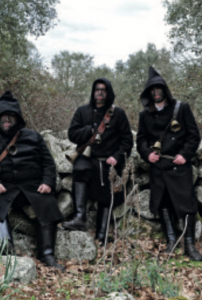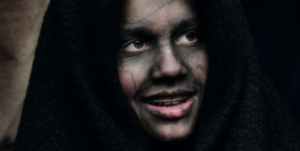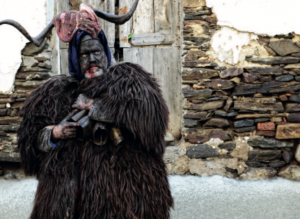Photojournalist Marina Spironetti travelled to inland Sardinia and the remote region of Barbagia to document the most fascinating and ancient carnival traditions of the island…
Sos Thurpos, Orotellisos

Sos Thurpos from Orotelli represent another centuries-old tradition. Unlike the masks in Mamoiada and Ottana, they don’t wear sheepskins but a simple black coat, handmade chaps (gambali) and shepherd boots. Another distinctive thing is a small chain of bells worn over the shoulder.
During the traditional parade, the Thurpos proceed in pairs, like oxen under a yoke, and are led by a third person, the Thurpu, who uses a goad to steer them. The meaning of this carnival is all about the rites associated with harvest.
A man helps a friend to paint his face black using burnt cork before the traditional carnival parade in the town of Orotelli. Unlike other Sardinian carnival figures, Sos Thurpos don’t wear a mask.
Su Battileddu, Lula

Nobody wears a mask here but faces have to be painted black. Even visitors are strongly encouraged to do so before the carnival begins. The ceremony of the Battileddu is considered the eeriest in the Barbagia region – to keep everybody happy, there is a huge barrel of wine on a cart that follows the procession, and everybody is invited to have a free taste.
The mask of Su Battileddu is one of the most impressive of the area. The word battileddu comes from the Sardinian term battile, which indicates an incompetent, useless person. The figure of the Battileddu represents the sacrificial victim – the whole ceremony is a reenactment of his death, which takes place in one of the squares of the small village of Lula, after a long (and rather rough) procession in which the Battileddu is persecuted by the other masked figures of the carnival.

What makes the costume of the Battileddu unique is an ox stomach full of blood that he wears on his belly, partially hidden by his long sheepskin coat. Other costumed figures as well as people from
the public will try to hit him in order to break his stomach and let the blood out. The Battileddu’s death and the shedding of his blood are related to ancient fertility rites.
